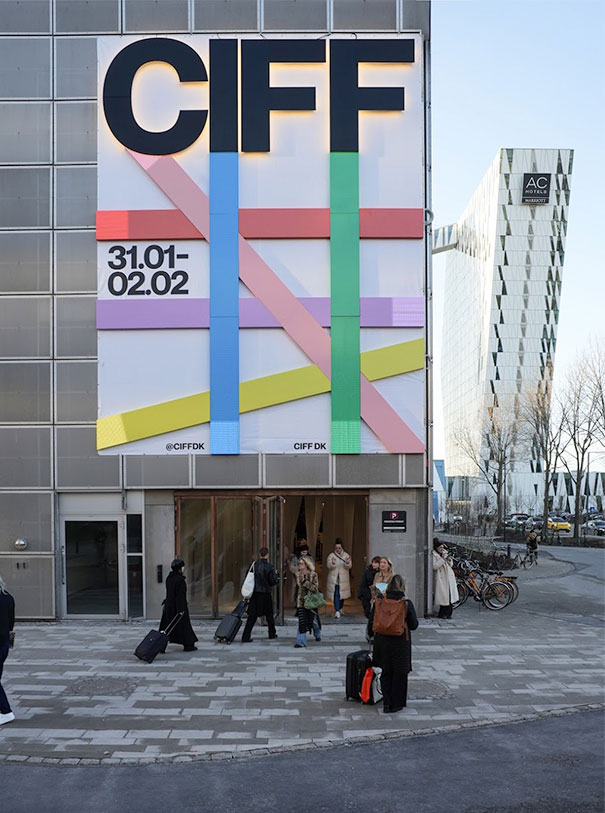We are in a transition
CIFF Director Sofie Dolva about the future of fashion fairs
March 25, 2024

A year ago, the Copenhagen International Fashion Fair (CIFF) acquired its trade fair competitor Revolver. The fashion industry needs to collaborate more to shape the post-pandemic era, was the message CIFF director Sofie Dolva at the time. And it still is.
We talked with CIFF director Sofie Dolva about her plan for the future, the appeal of Danish fashion and the biggest challenges the industry is facing right now.

CIFF director Sofie Dolva
ACHTUNG: Everyone loves to come to CPHFW. What makes it so attractive?
Sofie Dolva: The Danish fashion industry’s relevance in the international scene can be attributed to its strong design aesthetic, minimalism, and commitment to sustainability. The sustainability approach is definitely unique. Copenhagen Fashion Week was the first to implement sustainability criteria for brands who want to get on the schedule. Also, it is known for its community-oriented atmosphere and support for local brands. The city is so small and condensed so you can easily experience the vibe without being lost.
A: How do you try to implement the sustainability aspect into a fair?
SD: We rather try to provide than demand. We offer a deploy-and-play solution for the brand booths, so you cannot come up with something that is not reused. And we try to educate, and get experts within the field, providing workshops, events, and tools to help brands become more sustainable. Especially for emerging brands it sometimes can be challenging to act sustainably.

Copenhagen Fashion Week was the first to implement sustainability criteria for brands

The Danish capital’s fashion week is known for its community-oriented atmosphere and support for local brands
A: Speaking of challenges, what are the biggest challenges that brands and retailers are currently facing in the fashion industry?
SD: It is no secret that the market has been really challenging and sellouts have been declining. A vicious spiral of increasing discounts is putting a lot of pressure on the brands and retailers for their earnings. We all need to think outside the box. Private partnership programs between customers and brands are one example. Focus more on the community and loyalty around the brand. That is also why we see a comeback in physical retail as brands recognize the importance of flagship stores and consumer presence. It is about awareness and being out there, building a relationship with your customers.
A: What does this situation imply for emerging brands?
SD: Emerging brands face the risk of not being recognized or supported by retailers, as they simply do not know if they will survive. This is why CIFF is actively working to support them throughout the year. We try to be more of a business partner. Most of them are super creative but never learned how to run a business. We provide them with a space for their offices or creative production, we have an area of 66.000 square meters dedicated to them, we support them with their shows and our sales team helps them to have all the right tools ready for the fair.

Physical retail and the importance of flagship stores and consumer presence is coming back

CIFF provides young designers with a space for their offices or creative production with an area of 66.000 square meters dedicated to them
A: The role of trade fairs has been questioned during the pandemic. How do you think the business will evolve in the future?
SD: The time of having trade shows everywhere and all around the world is over. We are in a transition, also when it comes to the concept of trade shows. We need to be more than just a bi-annual fair, the focus is on transforming the trade fair into a more inspiring and worthwhile experience, using our community to align with different countries and provide a platform. For instance, last September we did a showcase with the CFDA in New York, bringing together 10 Danish and 6 American like-minded designers. We try to have smaller hubs and events, offering resources and opportunities throughout the year. And we create awareness for the brands to give them a bigger return on investment not just concerning the order part, bringing in more buyers and retailers from around the world. I think the future of trade fairs is to become more of a 360-degree partner and platform.
A: CIFF is like one of the longest-running fashion fairs in the northern part of Europe. What is your personal vision for its future?
SD: I like it to be even more international. And I also hope we can keep building bridges to other countries as we already did with the CFDA or Pitti Uomo. In fact, already this year 40% of our brands are not Nordic, highlighting the event’s international appeal. Also, 60% of the visitors who had pre-registered came from outside Denmark. We are getting more and more requests from Germany, the UK, Belgium. Many of these countries are searching for a commercial platform. We have a big potential.

CIFF plans to offer smaller hubs and events throughout the year

The event’s international appeal is increasing

